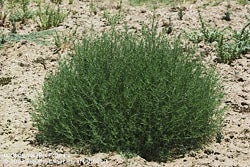Russian Thistle, Salsola australis
The Situation: Russian thistle, commonly known as tumbleweed, is a profusely branched annual herb. Its efficient taproot, abundant seed production and reduced leaf surface adapt this weed well to disturbed semiarid agricultural environments, rangeland and nonagricultural areas such as vacant resident lots and railroad or highway rights-of-way. It has become pervasive as an exotic weed species throughout California and the western United States.
Damage: Russian thistle is damaging as a seed contaminant, as a forage weed that may contain toxic levels of soluble oxalates and nitrates, and as an alternative host of several economically significant insect species. The mature plants break off at ground level, creating spiny, brittle, windblown tumbleweeds that fill drainage canals, catchments and swimming pools, and pile up against fences and dwellings, becoming eyesores, fire hazards, and foci for the accumulation of other windblown debris.
Economic Impact: In addition to being a nuisance, Russian thistle is an expense to both public and private property owners. While the economic impact to the state of California has not been well documented, costs include clean-up of public roadways and thoroughfares, loss of seed crops due to contamination by thistle seed and illness or even death of foraging livestock, and degradation of California's valuable and highly diverse wilderness areas.
Distribution: Russian thistle is a summer annual native to southeastern Russia and western Siberia and was originally introduced into the United States as a contaminant of flax seed in South Dakota in 1873. Within 20 years, it had spread to 16 western states and several Canadian provinces. It is now widespread throughout western North America, including virtually all arid and semi-arid regions of California and Russian thistle infests around 100 million acres of land.
Research: Russian thistle is an exotic weed species and is a good candidate for biological control. A pith-boring moth and a case-bearing moth have been established as biocontrol agents in California, but are ineffective. Additional insect enemies from the weed's native central Asia should also be introduced and evaluated. Mites, moths, and beetles that exhibit sufficient host specificity may potentially be effective natural enemies of this weed. Phytopathogens may also offer promise and should be investigated as possible biological control agents. The California Department of Food and Agriculture and the University of California Exotic Pests and Diseases Research Program has supported foreign exploration by USDA and UC entomologists in recent years, and natural enemies have been studied at the USDA European Biological Control Laboratory in southern France.
Center for Invasive Species Research, University of California, Riverside
Text provided by Richard D. Goeden, updated by Mark S. Hoddle
Photos courtesy of UC IPM and Jack Kelly Clark
Mark Hoddle, Extension Specialist and Director of Center for Invasive Species Research
mark.hoddle@ucr.edu
Personal Website


